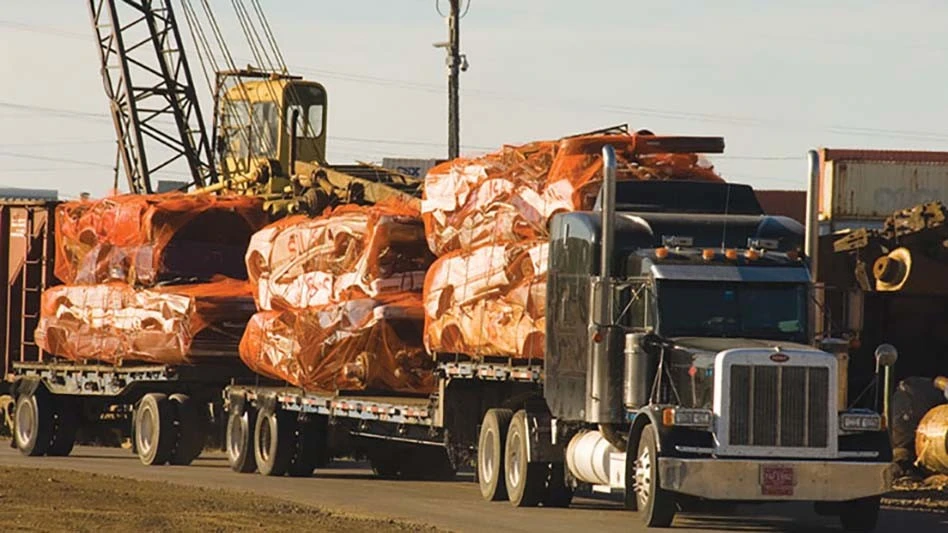
Photo courtesy of Schnitzer Steel
Schnitzer Steel Industries Inc., headquartered in Portland, Oregon, has announced preliminary results for its fiscal 2023 first quarter ended Nov. 30, 2022.
For the quarter, the company says it anticipates:
- a diluted loss per share from continuing operations to be in the range of (64 cents) to (69 cents) and a net loss to be in the range of ($18 million) to ($20 million) and net loss per ferrous ton in the range of ($21) to ($23);
- adjusted diluted loss per share from continuing operations to be in the range of (44 cents) to (49 cents), which excludes expected charges of $7 million primarily related to asset impairments and restructuring and other exit-related activities; and
- adjusted earnings before interest, taxes, depreciation and amortization (EBITDA) to be in the range of $6 million to $8 million and adjusted EBITDA per ferrous ton in the range of $8 to $10.
The company says its quarterly results reflect an estimated adverse impact of approximately $18 million, or $21 per ferrous ton, from extended operational disruptions at the Everett, Massachusetts, and Oakland, California, metals recycling facilities that were resolved in November.
"Our first quarter results were impacted by an extended shredder outage at our Everett facility and a regulatory issue limiting operations at our shredder facility in California, both of which were resolved by mid-November,” says Tamara Lundgren, chairman and CEO. “These disruptions, together with tight supply flows from the lower price environment and weaker economic activity, resulted in significantly lower sequential ferrous sales volumes. Since the end of the quarter, however, we have seen a strengthening in sales prices and demand for recycled metals in both the export and domestic markets. With the operational disruptions now behind us, we are expecting significant improvement in our second quarter results.
“Looking beyond current market conditions, we believe the structural demand for recycled metals remains positive, supported by the transition to low-carbon technologies, the increased focus on decarbonization and the expected funding related to the Infrastructure Investment and Jobs Act and the Inflation Reduction Act, including Buy Clean provisions,” Lundgren adds.
Demand weakened throughout the quarter, influenced by macro concerns globally, including slower growth, the impact of China’s COVID lockdowns, inflationary pressures, the strength of the U.S. dollar, and steel inventory destocking. The company says it expects average net selling prices for ferrous, nonferrous and finished steel to be down sequentially by 12 percent, 14 percent and 9 percent, respectively. These lower prices led to significantly tighter supply flows and compression of metal spreads. Ferrous and nonferrous sales volumes are expected to decline by 33 percent and 12 percent sequentially, which includes the impact on supply flows and sales volumes from the disruptions in Everett and Oakland and several ferrous shipments slipping into December. Finished steel sales volumes are expected to decline by 6 percent sequentially. Previously announced productivity initiatives targeting annual benefits of $40 million are expected to deliver a nearly full quarterly run rate of benefits in the first quarter, helping mitigate the impact of inflation on operating costs, the company adds. The detriment from average inventory accounting is anticipated to approximate $2 per ferrous ton.
Schnitzer says operating cash flow is expected to be negative in the range of $60 million to $65 million, reflecting an increase in net working capital because of the annual payment of incentive compensation accrued in fiscal 2022 and higher inventories in light of the shipment delays. Capital expenditures are expected to be approximately $48 million. Total debt is expected to be $358 million at the end of the first quarter. The effective tax rate for the first quarter is expected to be a benefit of approximately 26 percent.
Latest from Recycling Today
- BlueScope, BHP & Rio Tinto select site for electric smelting furnace pilot plant
- Magnomer joins Canada Plastics Pact
- Electra names new CFO
- WM of Pennsylvania awarded RNG vehicle funding
- Nucor receives West Virginia funding assist
- Ferrous market ends 2024 in familiar rut
- Aqua Metals secures $1.5M loan, reports operational strides
- AF&PA urges veto of NY bill





